Dennis Flavin, painter
His friendship with accomplished artist Joseph Solman, why he didn’t pursue art as a career, advice for making art, and much more
A legion of people like Dennis Flavin. He’s widely known around Rockport and Gloucester, MA, for his friendly demeanor, colorful and exuberant paintings, and the much-loved restaurant Halibut Point that he captained for 40 years. If you don’t know Dennis, you can get a sense of his energetic personality from this gallery talk video.
Dennis nicknames people he likes—a woman who worked for him is “Ha Ha.” A neighbor who dropped in while I was visiting is “Beard.” Beard has what Dennis calls a “machine gun laugh,” a description that made me laugh, albeit not machine gun style. Painter John Terelak (see my recent interview with him), who Dennis calls “the Great Chibatzo,” is Dennis’s close friend.
When I visited his Annisquam studio, Dennis’s hospitality was set to “maximum,” which I think is the only setting. He insisted the staff photographer (my husband) and I enjoy a cup of coffee, apple cider, or seltzer before we sat down to chat, and later he graciously offered up Fudgsicles.
Dennis, 74, revels in storytelling, reflecting on life lived and still being lived in the present. Yes, always in the present. He fondly recalls his hippie days as one of his favorite times of his life, but tells me, “That’s a story for another day. I can't tell you my whole life history because it's impossible!”
Walking about his studio within an antique barn, I saw many deliberate as well as accidental tableaus, many with their own stories. One featured a sentimental postcard from painter Joseph Solman—one of “The Ten”—and photos of Dennis hanging out with him. Joseph Solman looms large in Dennis’s story and his studio, which is enriched by his mentor’s paintings and monotypes.
I loved the photo of Dennis painting in Lanesville beside the 1951 Desoto he bought for $100.
When his children made art throughout their childhood, Dennis insisted they sign and date it. Some of these treasures are framed and hanging in his studio.
Dennis told me he “lived in the art room” at his Longmeadow, MA, high school. He said he arranged his class schedule to focus solely on art in his senior year. He remembers setting personal goals: (1) Go to school in Boston (he attended Vesper George School of Art), (2) Marry someone outside of his hometown (he married Peggy three months after meeting her at a party), and (3) Have three to five children (he and Peggy had three: Gabriel, Mercedes, and Ariel).
He said he loved art school and never missed a class at a time when many of his classmates were skipping class, smoking joints, and just hanging out. When an art model was a no show for a drawing class, Dennis agreed to model in exchange for the instructor’s charcoal on paper portrait of him. It hangs prominently in the studio.
Early on, Dennis decided he wouldn’t make art his livelihood. He didn’t want his art to be influenced by money, so he chose a comparatively stable and lucrative career: restauranteur. Despite the demands and long hours of running restaurants, he always found time to paint.
Dennis made dreamlike representational paintings, often reflecting personal stories and dramatic life experiences, and evolved toward the abstract. Vibrant colors and layers of pastel or paint are earmarks of his work. This past September, the public was treated to a solo show, 50 Years of Color, at the Cultural Center at Rocky Neck in Gloucester, MA. His daughter Ariel curated the show. It was a small sample of his collection that fills flat files, his studio loft, and a storage space. As with many cerebral artists, Dennis makes paintings that come with stories.
Currently, Dennis and Peggy reside in their fourth in a series of antique houses in Cape Ann. It was built in 1760 and reflects the time with its small scale, low ceilings, and charm. Peggy is an expert on antique house design and preservation. You can view her interior design and handmade dolls on her Instagram. The previous inhabitant of Dennis’s studio was Folly Cove Designer artist Peggy Norton, who used the barn to make linoleum block prints on fabric.

After spending a couple hours at his studio, I left feeling a bit lighter and inspired to paint something colorful and be nice to people. Here is our October 2024 conversation.
What did studying art at Vesper George School of Art in Boston do for you as an artist?
It taught me how to use my mediums [paint, pastel, charcoal, etc.]. Once I learned my mediums, then I knew what I was doing.
What job did you have after art school?
I worked at the Copley Plaza Hotel in Boston and then the Hampshire House [home of the Cheers bar] as a cook. [At the time, he was living nearby on Charles Street with his wife and first child Gabriel, and painting at a small studio near South Station.]
What brought you to Rockport?
John Terelak, who I met at Vesper George, invited a few students to come here on scholarship. Four or five of us stayed in cottages in Pigeon Cove, near Halibut Point [the quarry and state park], and we went out every day and painted. Then I saw Main Street in Rockport and couldn’t believe how beautiful it was. That was about 54 years ago. [He and Peggy moved to Rockport soon after that.]
I painted always. I never stopped painting.
Why did you decide not to pursue art as your career?
I knew if I tried to make a living with my art, it would ruin it because I'd have to worry about making art to sell it. I showed my work at a couple of galleries, and I hated the whole business, so I stopped doing that. But I kept painting and drawing with oils and pastels and making linoleum cuts and etchings. Then Joseph Solman taught me how to do monotypes.
Tell me about your friendship with Joseph Solman.
That's a huge story…I could start crying when I think about my relationship with Joe Solman. I loved the guy so much.
I went to New York to meet him, and the next thing you know, I was staying at his apartment near the Bowery. He and his wife Ruth would sit at the table, eating and arguing about politics. They would yell at each other, but they loved each other.
I would take the train from 128 [outside Boston] to New York, take a cab to his neighborhood, and call him from the payphone at the Irish bar across the street from his place. We’d greet each other with a hug at the bar and then talk. We went to all the museums.
Often we would just walk the streets of New York, smoking cigars. I wasn't scared of anybody [This was in the 1970s when muggings were more commonplace]. He was this short little Jewish guy with little clothes on—he wore the same clothes no matter what time of year it was—and I was this tall guy.
He gave me a Jewish name, “Dennis Fineman,” and would say, “Dennis is a fine man.”
What did you learn from Joseph Solman?
How to live as an artist. His attitude toward life, his attitude toward art, keeping everything simple. The beauty of life. He never drove. He walked around. He watched the Empire State Building being built, brick by brick.
Art was his whole life. He would wake up late, take a walk, and come back home and paint.
It sounds like you feel good about the decision you made a long time ago: not to focus on selling your art.
My art was not for making money. It was for me to paint and get better. And now, I’m retired, kind of, and I feel like it's time to get my artwork out so people can look at it.
You ran the much-loved Halibut Point restaurant for 40 years. You made art during that entire time and also had a family. How did you do it all?
I just did it. I don't know how I did it. At the time, I had a studio near the restaurant, in the same building where John [Terelak] had his art school. I would go there and paint and then go back home. I was only working 70 to 80 hours a week then [He said “only” because there were times when he worked nearly double that many hours] and somehow was painting in between.
Many of my friends say Halibut Point was their special place for hanging out with friends.
It was like a family. I only hired crazy people and I loved every one of them. I had 26 employees at one point.
I made it special for little kids and had toys for them. When single women, older people, and families with children came through the door they were waited on immediately.
The restaurant was also the training ground for Dennis’s daughter Mercedes, who worked there as a teenager, attended the Culinary Institute of America, and now co-owns Solo Italiano in Portland, ME.
Tell me about the evolution of your art from representational to abstract.
There were abstract elements even when I started. When I drew a model, I would draw the shadows on the model and the shadows and the big shapes around the model, on the outside.
At first, people would say, "What are you doing?" And then at the end, they'd say, "Wow," because I put it all together. That's the whole secret about art. You start with something. You keep it simple. You can break it down if you want.
Dennis explained that he was often frustrated by weather interfering with outdoor painting sessions. He was also interested in painting more abstract forms. After a few years, he decided to shift to studio painting.
I decided that I was going to paint inside and that everything I was going to paint would be from my head [instead of from a reference photo]. That was around 18 to 20 years ago.
What advice do you have for making art?
Have a space to paint. It doesn't have to be big. It can be in the corner of a room. I had about 10, 12, 15 studios before this. Some were in beat-up buildings with no heat. Have your paint and palette out where you don't have to put it away.
Joe Solman painted in a place as small as this [we are sitting in 10 feet x 10 feet space within his larger studio] for 57 years. He made what he called subway gouaches. He'd see people on the subway reading the newspaper. He’d draw them on newspaper, then fill in the drawings at home.
What are your thoughts about the effective use of color?
I'm a colorist. I can make any object interesting with my color. Look at my palette. I buy paint in colors you've never seen. I buy the best I can get. [He likes Michael Harding paints.] I also buy the best quality pastels: Unison. They are very soft. And I make my pastels on sandpaper [large sheets of 240 grit].
Tell me about your etchings.
I did all the hiring at the restaurant. This skinny kid came in looking for a job. He said he never worked in the restaurant business. And I said, "Well, what can you do?" He said, "I do etchings." I told him I would give him a job if he would teach me etching. [Dennis named him “Scratch,” and the name stuck with the restaurant team.]
I learned really fast. He was amazed! I put a ton of hours in and made a lot of etchings. They are a lot of work. Just printing one is 11 steps.
What did you like about working in that medium?
I just loved the printing. I also made monotypes. I used to call it the moment of truth because with a monotype, if you're doing it with oil paint, you have to mix the paint so every brush stroke has the same thickness. If it's too thick, it blots the paper and you have to throw away the whole thing and start over. [Making a monotype involves applying paint to a smooth surface and making a single print.] So if I work on it for five hours, then I print it and it didn’t work out, I’d have to rip it up.
How would you describe your body of art?
Insane, crazy, fun, but not always fun. People often say to me that painting must be so relaxing, but sometimes it’s torture. It’s hard to explain…
I can't stop painting. Behind every great artist has to be a great wife.
How does your wife support your art?
Peggy comes over and looks at my work and talks to me. She lets me put in a million hours. She never bothers me about anything. She's an artist in her own right—she makes dolls. She hand sews every finger, hand, arm, and leg.
What is your state of mind when you're at your easel?
I don't plan my paintings, but I know way ahead they will be something. I keep it loose. I just keep going and next thing I know, I see something different. I'll put a line in. I'll draw a different section. I always leave some of the underpainting coming through. That underpainting is very important. I put down a color and then put another color over it and leave a little underneath it, and then another color over that. The next thing I know, I’ve got a painting.
Tell me about your Night Swimming painting.
I listened to the REM song about 20 times and wrote down the lyrics and then painted it. All of the words are in the painting.
A selection of Night Swimming lyrics:
“September's coming soon
I'm pining for the moon
And what if there were two
Side by side in orbit
Around the fairest sun?”
How do you think about your life as an artist today?
I feel great about it as long as I have a few more years so I can paint and not be hurting [he’s had a bout of debilitating back pain].
Peggy works in her studio all day. I'll meet her for dinner and breakfast. We talk a couple of times during the day. She's dedicated to what she does, and I'm dedicated to what I do. I listen to certain music [often it’s Bob Dylan, who Dennis has been listening to daily since he was 14 years old]. She listens to other stuff and we don't bother each other.
I don't care if it's morning, night, middle of the night. I can't sleep, so I'm up all the time. If wake up at four in the morning and I want to paint, I will paint.
Do you have a painting of yours that you won’t sell?
There’s a bunch of them. This one I won't sell [see Need Help below]. It’s a huge painting of this girl who worked for me and ended up living with us. She was an addict, and I took her under my wing and put her in rehab. When she got out, she worked for me as a manager for around 15 or 20 years.
What's something that you've learned recently that you think is interesting?
I’m learning all the time. Right now I’m relearning longhand handwriting [cursive] because I love to write. He pointed to a shelf of black journals and said he’s kept journals for years but has never gone back to read them. He also showed me the fountain pens he likes to use and one of his favored Uniball pens.
How come you never revisit your journals?
I don't live in the past. Every day is new to me. I just love every day. You can't worry about everything. When I had a restaurant, I'd worry, and you know, money is a pain in the rear end. It's a tool. You just have to stay healthy.
You're hosting a dinner party. You get to invite six people living or dead. Who are you going to invite?
I have so many friends, I don't even know where to start! [I realized that with his restaurant, he essentially hosted a large dinner party every night! Of course he couldn’t name just six people!] But definitely the great Chibatzo [John Terelak] and Willie Alexander [artist, musician, member of the Velvet Underground], and Joseph Solman.
Palate & Palette menu
Here’s what I would cook if Dennis and Peggy Flavin came to dinner, which they are invited to do:
Radicchio and butter lettuce salad with roasted honeynut squash, pecans, and champagne vinaigrette
Roasted swordfish with lemon artichoke pesto
Crispy smashed potatoes
Roasted Brussels sprouts
Ice cream
Where to find Dennis Flavin
Gallery talk at Cape Ann Museum (2013)
If you liked this…
Show your appreciation by clicking the like button below—I’d love to know you enjoyed the story.
Forward this to a friend and encourage them to subscribe.
See more than 60 stories about art and food at palateandpalette.substack.com.

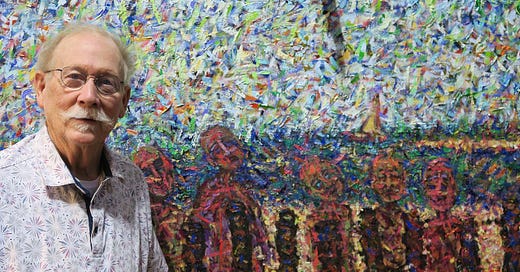



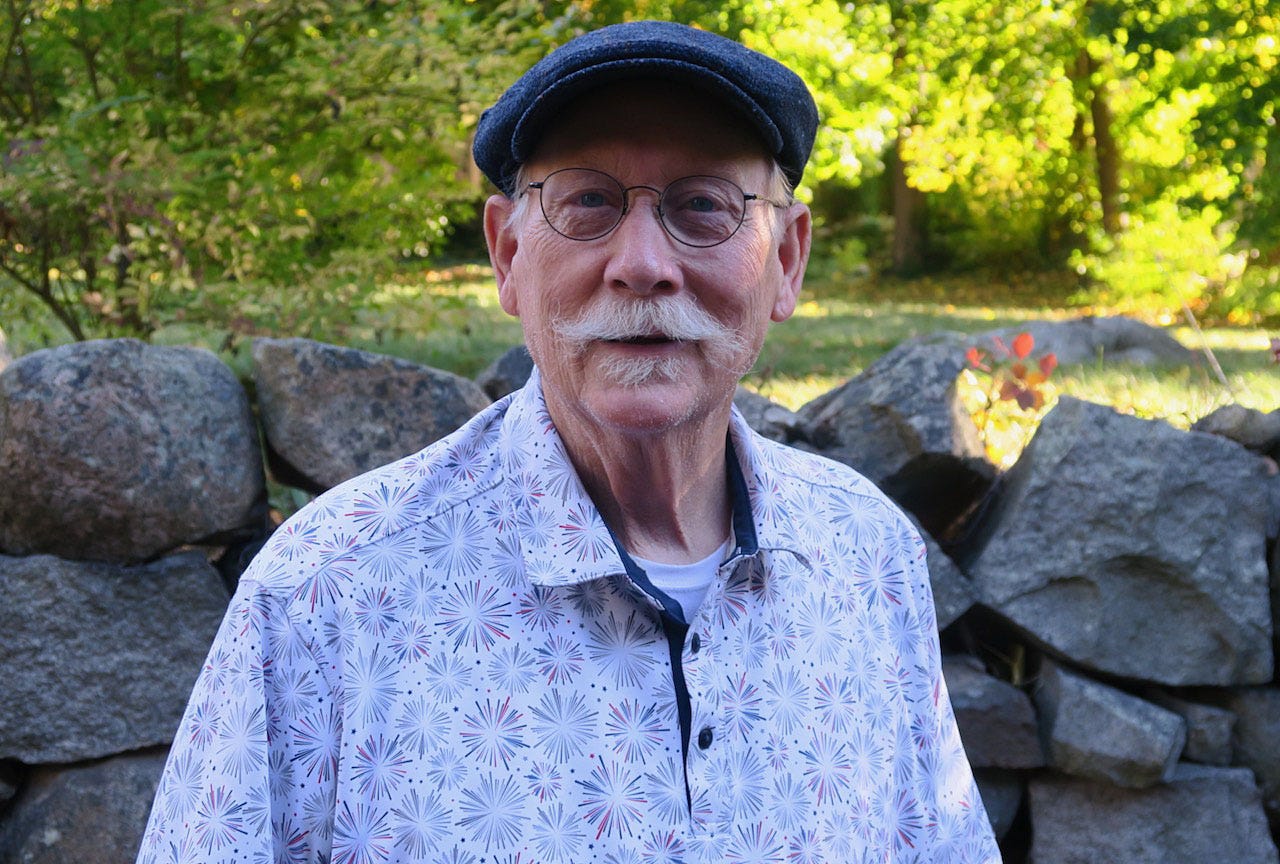
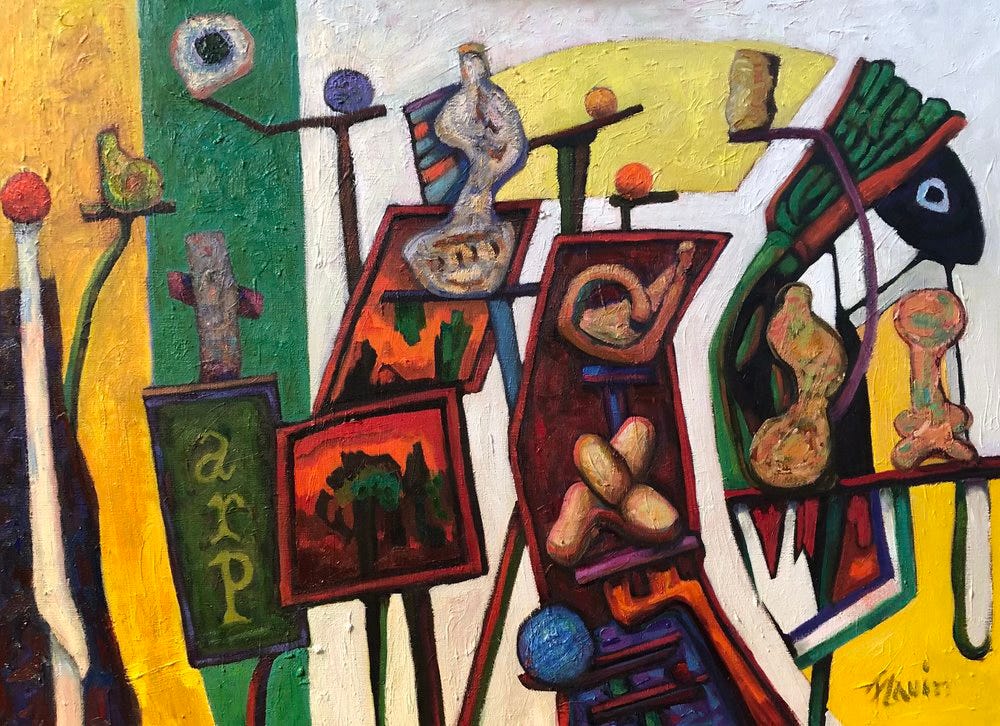

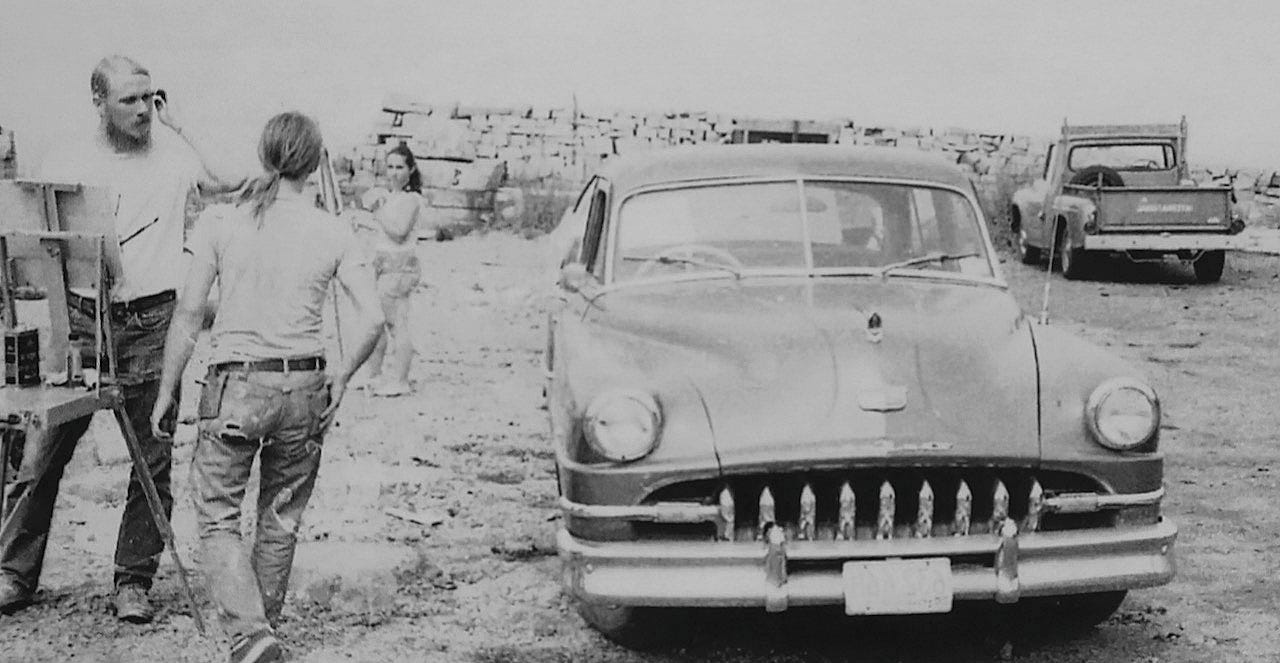

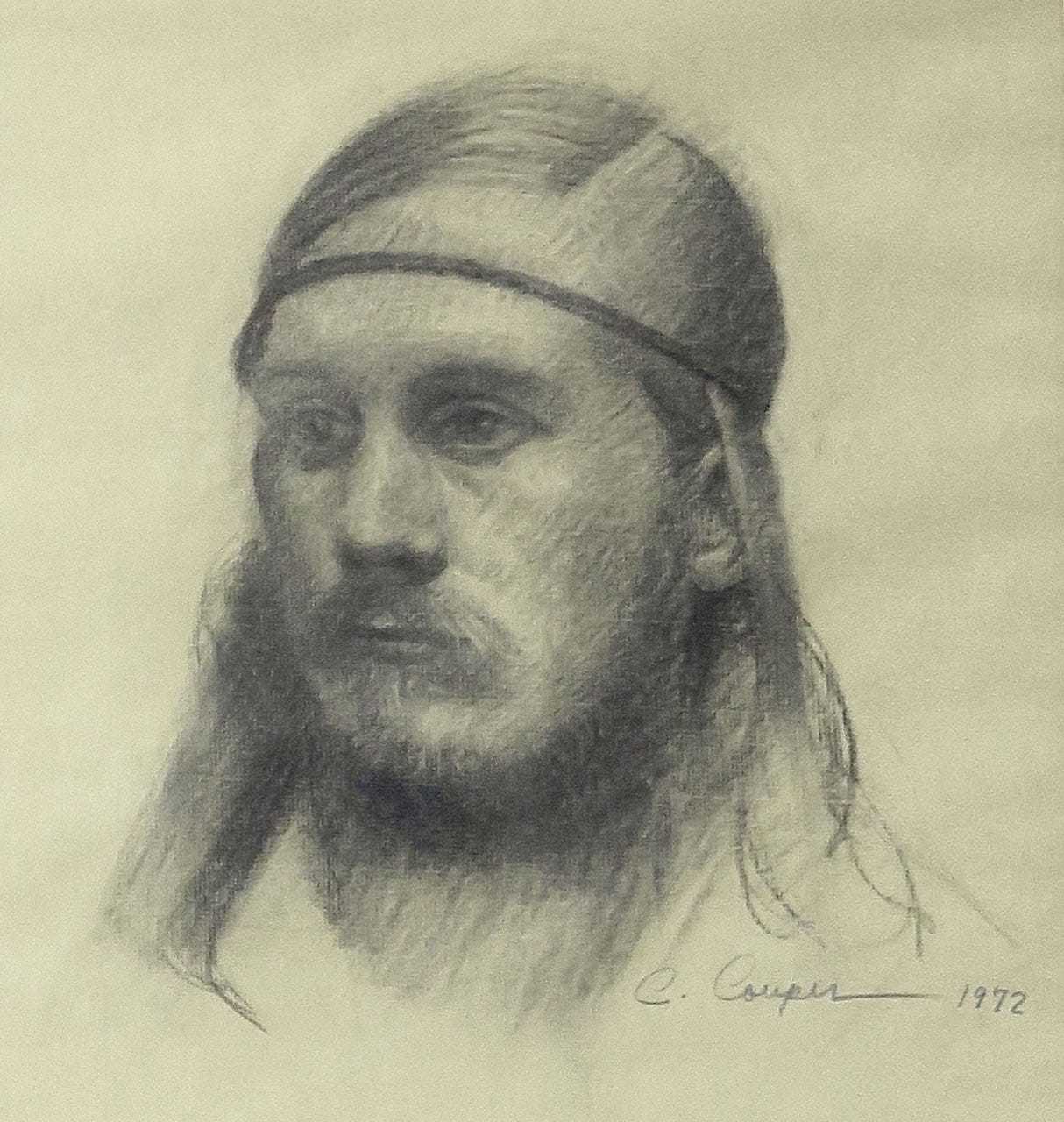

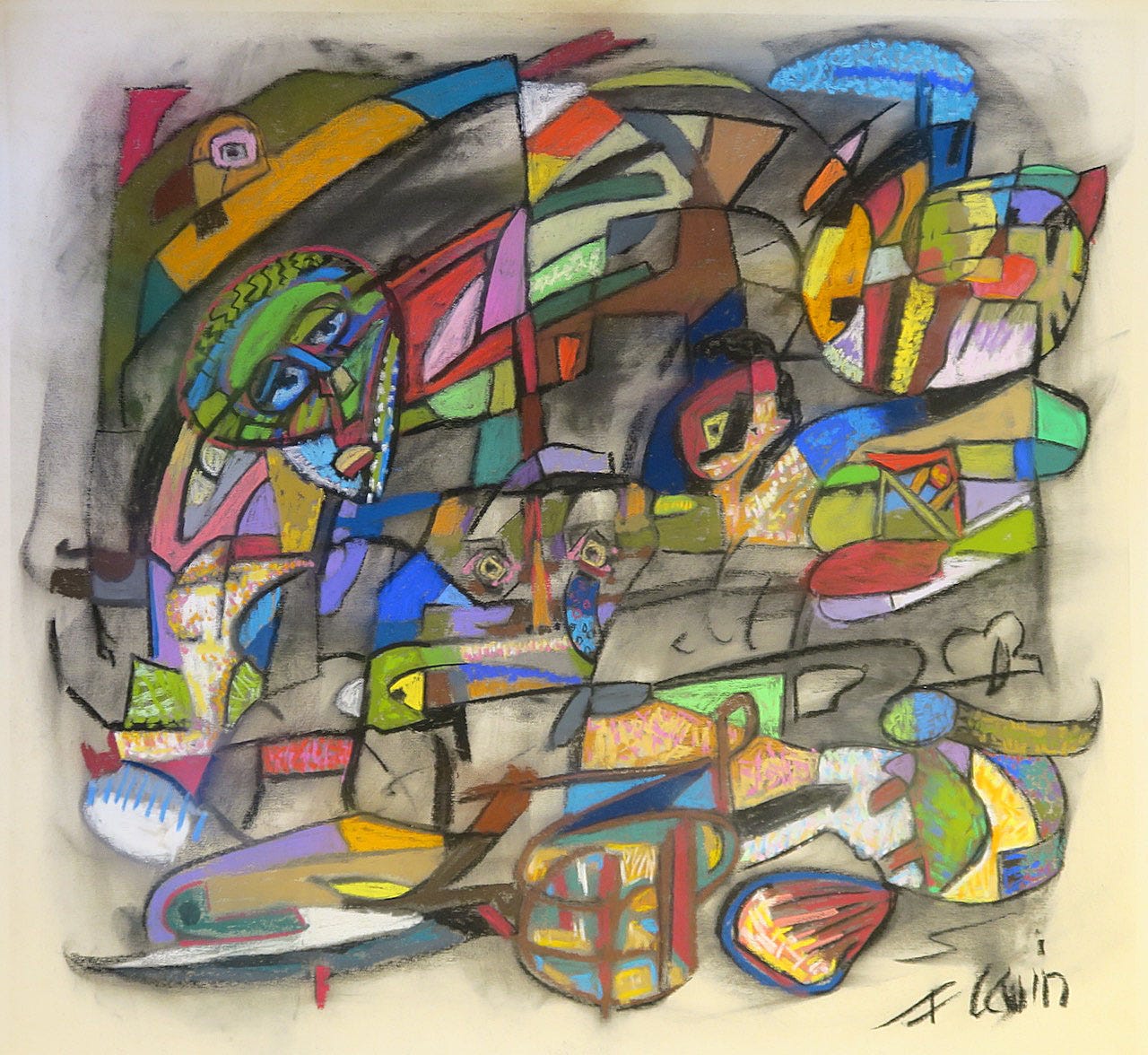


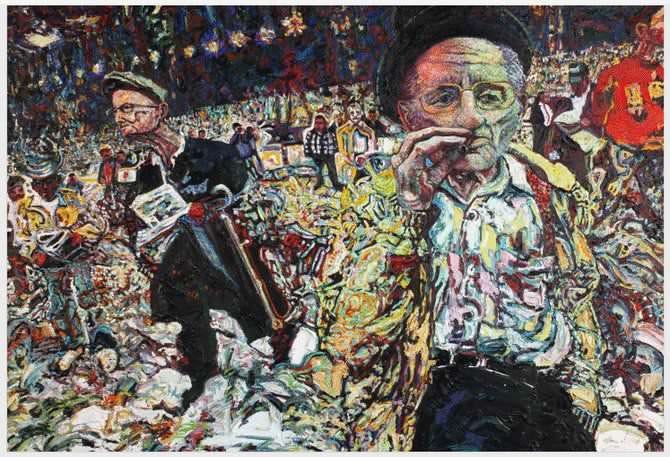
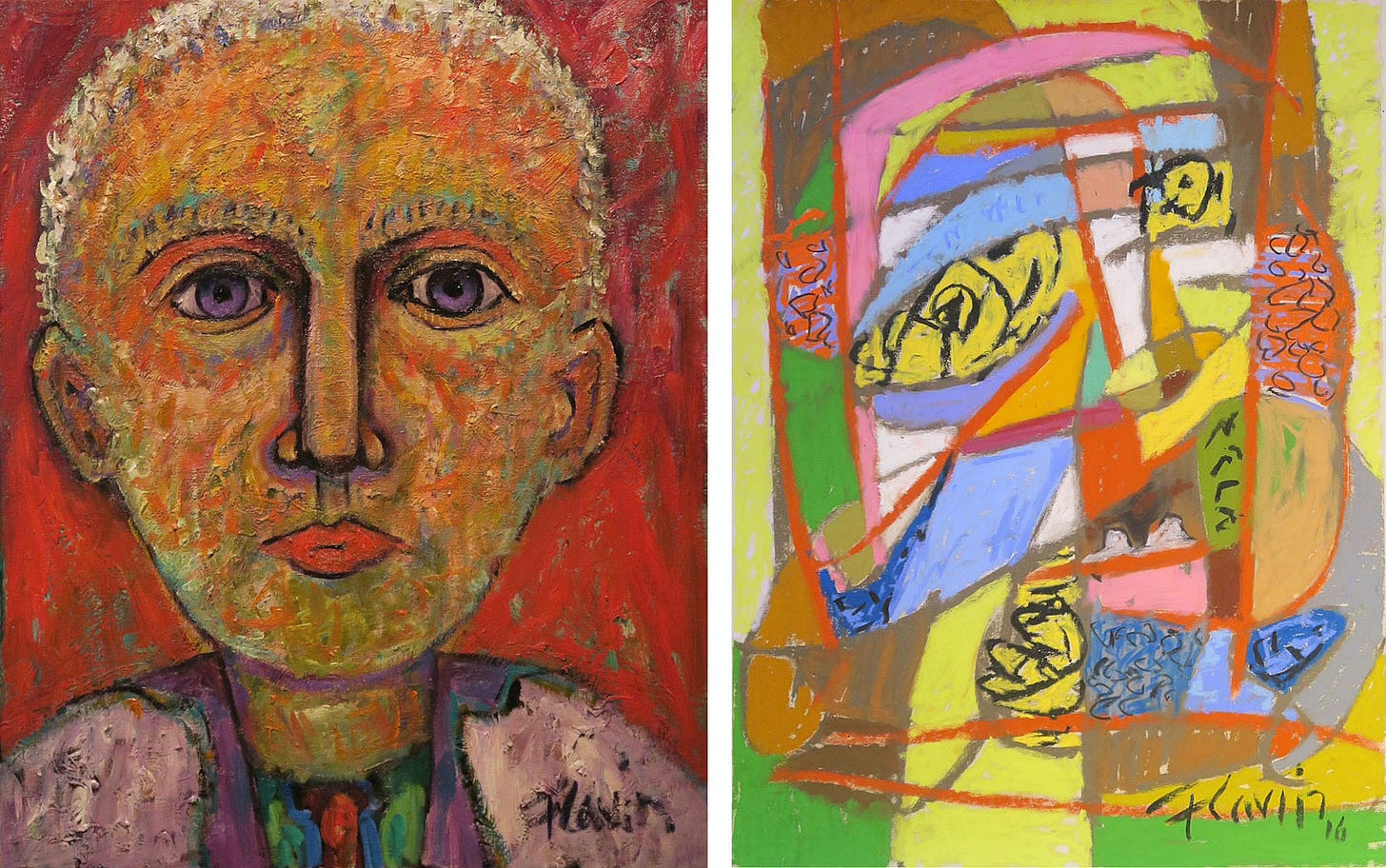
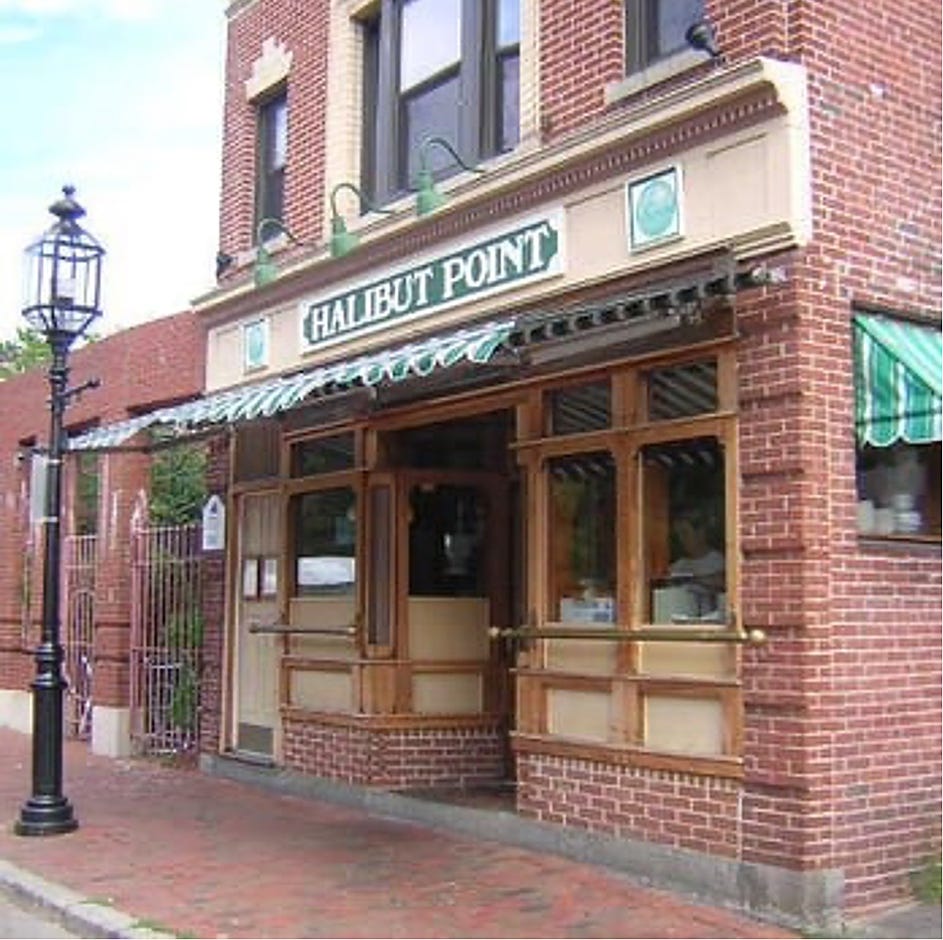
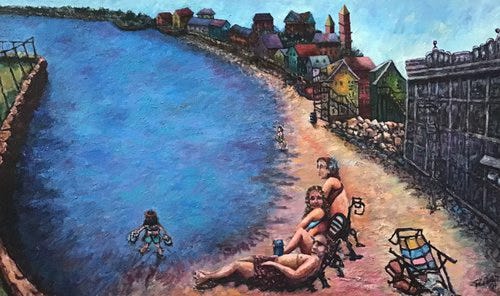
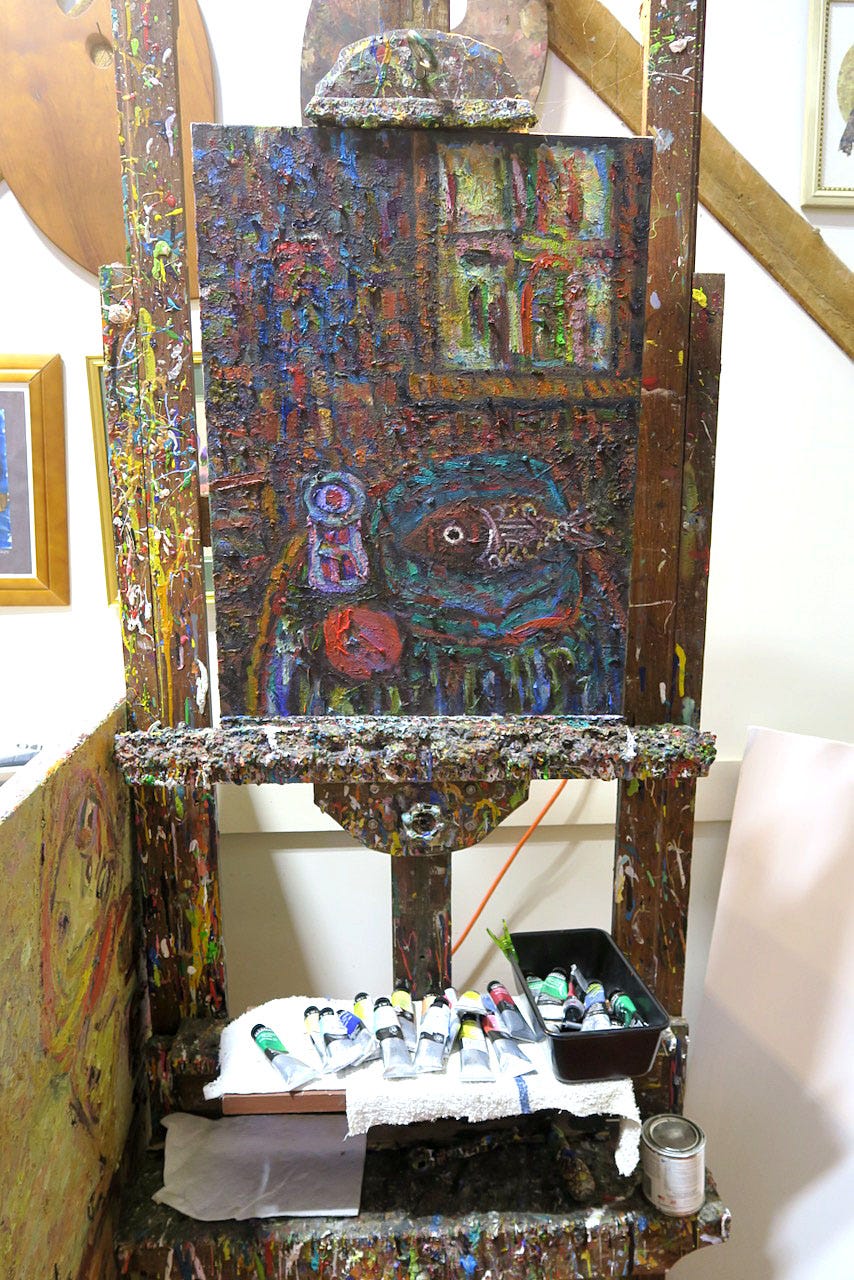
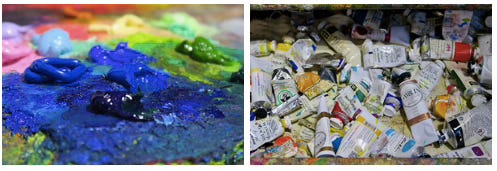



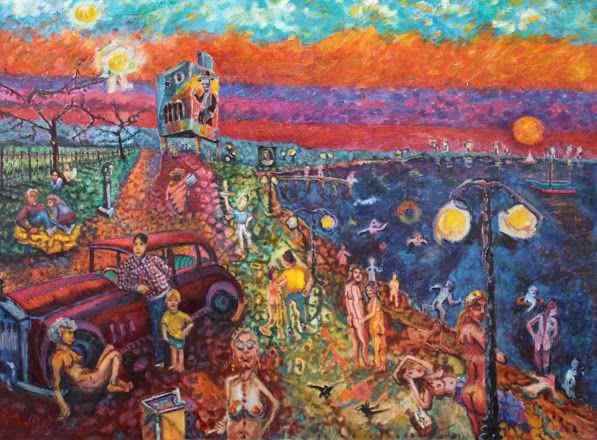
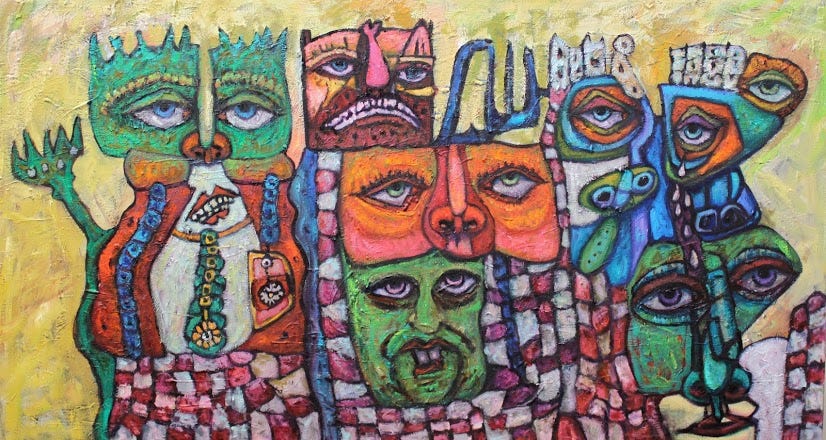
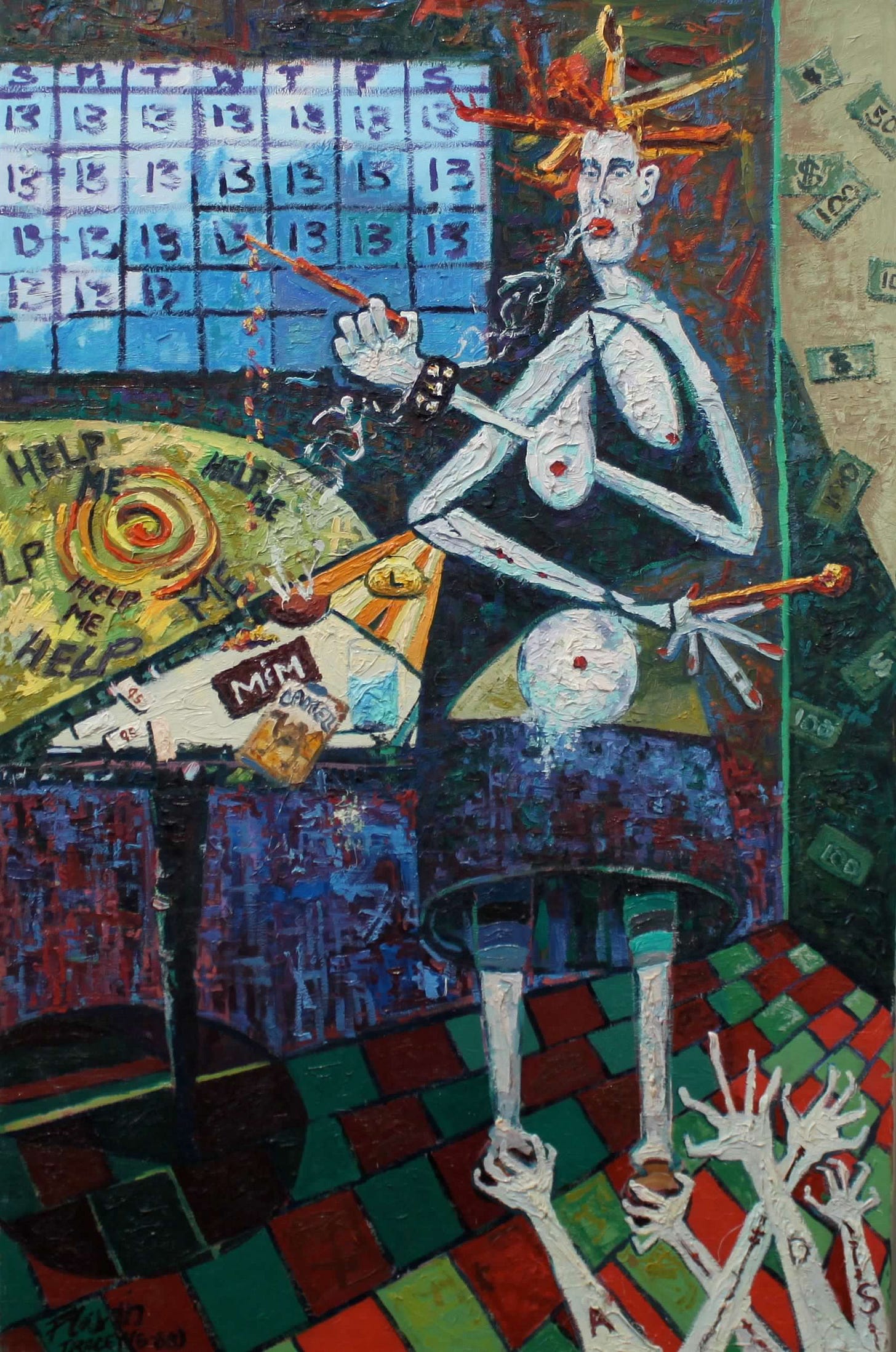


The juxtaposition of the marbles and the painting is perfect. Dennis sounds very energetic and I appreciate his penchant for handing out nicknames. My husband does that too!
My very talented brother in law! Love his work! Great article! You captured him perfectly!!